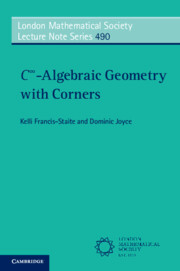Book contents
- Frontmatter
- Contents
- 1 Introduction
- 2 Background on C∞–schemes
- 3 Background on manifolds with (g–)corners
- 4 (Pre) C∞–rings with corners
- 5 C∞–schemes with corners
- 6 Boundaries, corners, and the corner functor
- 7 Modules, and sheaves of modules
- 8 Further generalizations and applications
- References
- Glossary of Notation
- Index
3 - Background on manifolds with (g–)corners
Published online by Cambridge University Press: 05 January 2024
- Frontmatter
- Contents
- 1 Introduction
- 2 Background on C∞–schemes
- 3 Background on manifolds with (g–)corners
- 4 (Pre) C∞–rings with corners
- 5 C∞–schemes with corners
- 6 Boundaries, corners, and the corner functor
- 7 Modules, and sheaves of modules
- 8 Further generalizations and applications
- References
- Glossary of Notation
- Index
Summary
A ‘manifold with corners’ is a space locally modelled on [0,infinity)^k x R^{n-k}, just as manifolds are locally modelled on R^n. Triangles, squares and cubes are examples. A manifold with corners X has a boundary dX, a manifold with corners of dimension one less. The boundary of a triangle is the three edges. If f : X -> Y is a smooth map of manifolds with corners then f need not map dX -> dY, i.e. boundaries are not ‘functorial’. But we can extend the boundary to the ‘corners’ C(X), a manifold with corners of mixed dimension, which is functorial, i.e. f extends to C(f) : X -> Y.
There are several notions of smooth map of manifolds with corners. We choose the ‘b-maps’ of Richard Melrose. There are two notions of tangent bundle, the ordinary tangent bundle TX, functorial under smooth maps, and the ‘b-tangent bundle’ bTX.
‘Manifolds with g-corners’ are a generalization with exotic corner structure. They have some nicer properties, e.g. existence of b-transverse fibre products.
Manifolds with corners occur in many places. e.g. in TQFTs, and analysis of partial differential equations. Some moduli spaces in Morse theory, Floer theories, and Symplectic Geometry are manifolds with corners.
Keywords
- Type
- Chapter
- Information
- C∞-Algebraic Geometry with Corners , pp. 50 - 72Publisher: Cambridge University PressPrint publication year: 2024

